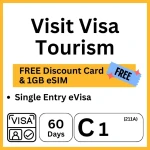Things to Do in Bali
What are the Visa Requirements for Tuvaluan Citizens?
Enter into Indonesia / Bali with Tuvaluans Passport
Tuvaluans have to apply for a B211A Visit Visa to travel to Bali / Indonesia for tourism purpose. With a Tuvaluan passport you can not get a Visa on Arrival at the moment. Please check the FAQ below for further details on your options on how to get a B211A Visa, the costs and process.
FAQ C-type Visit Visa for Bali / Indonesia
Basically you have two options.
1. ASSISTED Visa Agent Service
if the immigration website is hard, or you are not sure how to handle and what documents are needed etc, you can use an Agent to assist you and handle everything for you. Reliable Agent
INCLUDED in the Service:
- Document verification & validation
- Application registration and verified upload into the immigration online system
- Customer support
- Express Service available
- Sponsor & guarantee Letters (if required)
Our partner agency with whom we have worked since years is absolutely reliable, and efficient Surcharge Applies.
Details, Prices & Requirements & Online Application Form by PT Bali Wisata Baik
2. SELF-SERVICE - Online Application via official Immigration Website
If you can arrange all the necessary documents and don't use the assistance of a Visa Agent, then ONLY use the official Website of the Indonesian Immigration Department for your Visa application.
Citizens from 80+ countries MUST apply at least for a C-Type Visa if they want to enter into Indonesia
Nationality CheckCitizens from (almost) all countries can apply for a C-type Visa ( 60 days Visit Visa) and many do so, even if they don't have to. Because this Visa can be extended (max. stay in Indonesia 180 days)
However, travelers holding a passport of following countries CAN NOT apply for a simple tourist / visit Visa for Indonesia but would need to follow a special and expensive application & screening process (calling Visa). The fees are significantly higher.
- Afghanistan
- Guinea
- Israel
- Kosovo (not recognised)
- Liberia
- Nigeria
- North Korea
- Somalia
More Information and Prices on the Calling Visa
Yes, Indonesia recognises these travel documents. Visitors however need to apply for a C1 Visa, which we can facilitate for you. Infos & Prices
-
Titre de Voyage: This is a term often used, especially in French-speaking countries.
-
Refugee Travel Document: Many countries use the term "Refugee Travel Document" to describe this type of travel document.
-
Travel Document for Aliens: Some countries may use this more general term to describe the document for individuals who are not citizens.
-
Convention Travel Document: This term is associated with the 1951 Refugee Convention, which established the legal status and rights of refugees. The Convention Travel Document is recognized under this agreement.
-
Laissez-Passer: In some cases, the term "laissez-passer" is used, especially by international organizations. It essentially means "let pass" or "let travel" in French.
-
Certificate of Identity: This term may be used in some countries or by certain organizations.
-
Special Travel Document: Another generic term that can be used to describe a travel document for individuals with specific legal statuses.
-
Asylum Travel Document: In some countries, this term is used to describe the document issued to those granted asylum.
-
Document of Identity: Another term that may be used to describe a travel document for stateless individuals or refugees.
-
Passport Substitute: Some countries may simply refer to it as a passport substitute or a document that serves the purpose of a passport for certain individuals.
Yes this "60 days Visit Visa" for Indonesia can be extended.
- the initial Visa is valid for 60 days
- Day of arrival and day of departure count as full days
- The Visa can be extended twice, each time for 60 days, which gives you a total of 180 days max, that you can stay in Indonesia without having to leave the country
- If you overstay your Visa you will have to pay a penalty of IDR 1mio per day!
What you re allowed to do in Indonesia depends on the Visa Type you apply for, and therefore on your travel purpose
C1 Tourist Visa
- Visit Indonesia for the purpose of tourism
- Visit family or friends
- Attend meetings, incentives, conventions, and exhibitions as an attendee
You are not allowed to:
- be a speaker at events
- do or run a business ("make money")
- provide services including of course being a Yoga Teacher or life coach at seminars and retreats
C2 Business Visa
- Carry out activities related to business, meetings, or purchase of goods including but not limited to checking goods at the office, factory, or production site of goods.
- Discuss, negotiate, and/or sign business contracts.
- Conduct activities related to tourism, and visiting friends or family
C6 Social & Volunteer Visa
- For a person who conducts or participates in social program, humanitarian assistance, or volunteer program in Indonesia
- Conduct activities related to tourism, and visiting friends or family
C10 Event Speaker & Presenter Visa
- For a person who participates in meetings, incentives, conventions, and exhibitions or other similar activities as a speaker, lecturer, presenter, or public figure without being bound by a contract with a guarantor in Indonesia
- Conduct activities related to tourism, and visiting friends or family
C10A Religious Preacher Visa
- For a person who participates in meetings, incentives, conventions, and exhibitions or other similar activities as a religious preacher
- Conduct activities related to tourism, and visiting friends or family
You are NOT allowed to:
- do or run a business ("make money, get paid in Indonesia")
No.
The C-Type Visas are all "Single Entry Visas" only.
A Multiple Entry Visa is available - D-Type Visas (Info and Application Service)
YES you can travel all around Indonesia. This visa is for Indonesia and not just a region or specific island. Therefore any type of Visa (Visa on Arrival, or C1, C2 etc.) is always valid for Indonesia and you can travel within Indonesia freely .
Traveling to Bali?
Digital Discount Card
Save at 200+ Partners & 1GB FREE eSIM
Waterbom, Rafting, Padel & tennis, Accommodation, Car Rental & Tours, Trekking, Canyoning, e-Biking, Spa & Fitness, Restaurants, ATV, Scuba Diving, Devdan Dance Shows, Cooking Class, Airport Transfer....and more
Info & Prices
SMALL INVESTMENT - BIG SAVINGS
Get Ready for Your Bali Trip
Visas Discounts Int. Driving Permit eSIMS & Data Hotels & Resorts Airport Transfer Medical Insurance Customs Form Tourist TaxVISIT VISA - Visa on Arrival
Commonly known as Visa on Arrival for 90+ nationalities. Valid for 30 days, can be extended once.
VISA 211A
Applies to the countries not listed for the B1 Visit Visa (Visa on Arrival). Needed if you plan to stay longer than 60 days, 211A visa is extendable twice giving you the possibility to stay up to 180 days in Bali.
TRAVEL REGULATIONS
For your travel planning: All what you need to arrange and know before travelling to Bali and Indonesia. Tourist Tax, Custom Form etc























